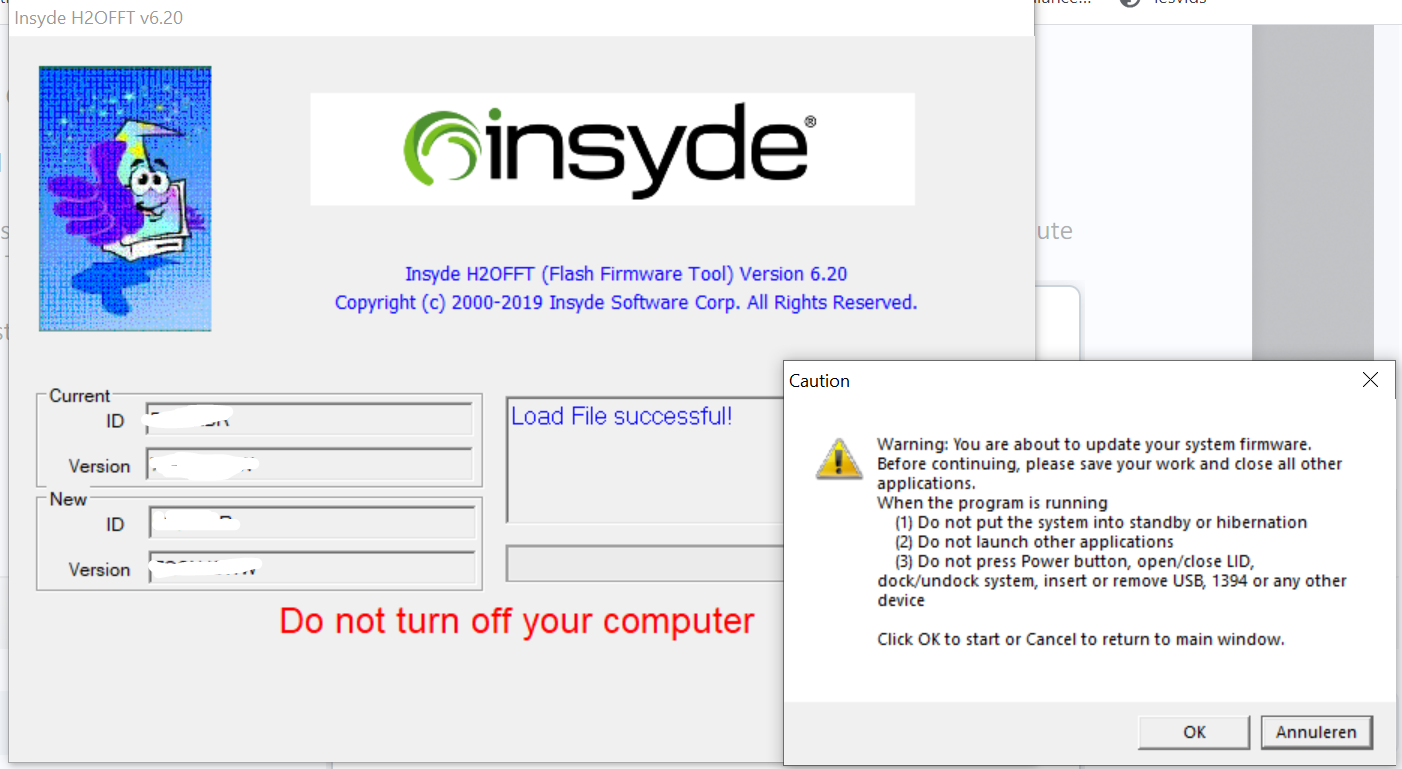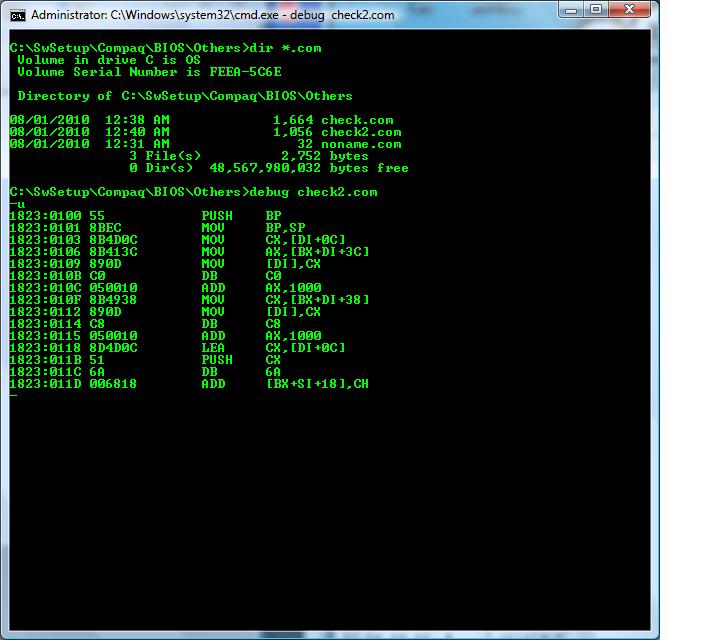- Insyde Flash Tool Free
- Insydeh20 Bios Update Tool
- Insyde Flash Tool
- Insyde Flash Firmware Tool
- Insyde Bios Update
Some time ago I bought an Alienware M14xR2 as my last laptop broke down. Lately, Alienware published an update for my BIOS that I can't burn in my computer because I only use Archlinux. By googling a bit I quickly found a tool for burning the BIOS in a DOS command line but I would need to have a look to the update package.
Just by executing the update file in a virtual machine in windows I soon figured out it was a self extracting package. I just searched %TEMP% files for the extracted version.
Ding.wav is just audio. I suppose it is played when flash is finished.Just by reading the header of the ini files we can guess they are configuration files for the flasher utility. The format is self explained in comments. In line 61 I found that the file I wanted for flashing was isflashWin.bin but after a fast attempt with FreeDOS and the tool I mentioned before I realised that the format was not FD as it should so I googled a bit more. As it turns out, Insyde has released a new update file format and as it seems it isn't documented.
Step 1 - Preparing working tools. Download and install 7-Zip. Download 'HP USB Disk Storage Format Tool' here. Save this file inside 'Toolbox' folder. Download 'DOS Files' here. Save this file inside 'Toolbox' folder. Download 'Flash It Tool' here. Save this file inside 'Toolbox' folder. Extract files downloaded in 2, 3 and 4. Re:Today i Received an BIOS update from Insyde H2OFFT ( Flash Firmware Tool ) Version 6.20 2021-07-08, 7:06 AM When I pressed Ctrl Alt Del in order to get to the task manager, it then continued and restarted and then did the update and everything was fine. Nov 03, 2019 Insyde Bios Flash Utility Download. I have an Aspire ES1-111M-C7DE whose battery is failing to charge. As a part of my efforts to remedy the problem, I am trying to flash the BIOS to 1.16. However, the InsydeFlash utility obtained from Acer's 'Support & Downloads' page will not run the BIOS update until the battery is at least 15% charged.
Inside the file I found a section that is exactly the same as the configuration file and it is preceded by a string quite suspicious.
I think these headers separate sections of the file as they are all 16 characters long. By having a look inside Hexedit I found that there is a padding of 8 bytes between the last character and some famous file magic numbers. I've done a simple python script (filesplitter) for splitting this kind of files and continue the analysis.
Part number four is clearly the configuration file. If you are trying to tweak parameters in platform.ini note that it wont work, but if you modify this part of the binary file it will. It seems that Insyde is now using the platform.ini only to point to the update file (isflashWin.bin) and then the utility just parses the configuration from there.I had no success in running one and two. I've tried FreeDOS and Windows 98 in DOS mode which should have support for MZ executables but in the best case I got no output and in the worse some memory address exceptions.I found that number three is related to a utility called Flashrom but I don't have much time to investigate. Maybe some readers can point me in the right direction.After having a look to five in Hexedit I think it can be a BIOS image although I don't really know about this topic.
Although I could not flash my BIOS I could find some little information about this new format and I also found that MZ executable signatures weren't in the binary analysis tool I use (binwalk). The latest version of binwalk now looks for MZ executables.
Please enable JavaScript to view the comments powered by Disqus.comments powered by Disqus
This article explain how to create a booteable USB stick to flash an EFI flasheable file under DOS enviroment.
Is my EFI InsydeH2O?
The easiest way to figure that is looking on the 'BIOS POST Screen' for this image:
Step 0 - Preparing the work enviroment
- You must create a folder on your desktop to use it as workspace. I will use one named 'Toolbox'.
- Your current Windows user account must have administrator rights.
- You must have the Windows based executable file that contains the EFI flasheable file. If you don't have one, enter to Support Website page and get one for your computer. I will use one named 'EFIUPDATEPACKAGE.EXE'.
- Step 0 done.
Step 1 - Preparing working tools
- Download and install 7-Zip.
- Download 'HP USB Disk Storage Format Tool' here. Save this file inside 'Toolbox' folder.
- Download 'DOS Files' here. Save this file inside 'Toolbox' folder.
- Download 'Flash It Tool' here. Save this file inside 'Toolbox' folder.
- Extract files downloaded in 2, 3 and 4. A folder will be created for each extracted ZIP file.
- Step 1 done.
Insyde Flash Tool Free
Step 2 - Creating a booteable USB stick
- Connect your USB stick. Make a backup of it contents if necessary.
- Open 'HP USB Disk Storage Format Tool' folder and execute 'HPUSBFW.EXE' with administrator rights.
- Follow these easy steps as shown below:
- Search and select 'DOS Files' folder:
- Click on 'Accept' button and then click on 'Start' button to initiate the process.
- A warning window appears. Click on 'Yes' button and wait until the entire process is completed.
- Click on 'Accept' button to close the summary window and then click on 'Close' button to close the application.
- Step 2 done.
Step 3 - Copying the flashing tool
- Open 'Flash It Tool' folder.
- Select all files and copy them to the root directory of your USB stick.
- Step 3 done.
Step 4 - Extracting the Windows based EFI update package
- Copy 'EFIUPDATEPACKAGE.EXE' file to your 'Toolbox' folder.
- Secondary click (left click) on 'EFIUPDATEPACKAGE.EXE'.
- Select '7-Zip', then select 'Extract to 'EFIUPDATEPACKAGE'.
- A new folder named 'EFIUPDATEPACKAGE' will be created with files inside.
- Open 'EFIUPDATEPACKAGE' folder and open 'platform.ini' file. It's important to keep this file open.
- Step 4 done.
Step 5 - Finding the flasheable EFI file
Insydeh20 Bios Update Tool
- In 'platform.ini' file, search for the section called '[FDFile]'.
- Look for the 'FileName' attribute. This attribute sets the flasheable EFI file name.
- Look inside your 'EFIUPDATEPACKAGE' folder for that file, and rename it to 'FLASHME.ROM'.
- Copy 'FLASHME.ROM' file to the root directory of your USB stick.
- Step 5 done.
Step 6 - Setting the computer platform
- Look inside your USB stick and open the 'IDS.id' file with a plain text editor (notepad is enough).
- In 'platform.ini' file, search for the section called '[Platform_Check]'.
- Copy each 'PlatformName' attribute (only if it have a non-empty value) to 'IDS.id' file.
- Saves changes to IDS.id file.
- Step 6 done.


Insyde Flash Tool
Step 7 - Finishing
Insyde Flash Firmware Tool
- Close all files and folders opened.
- Remove securely your USB stick.
- Step 7 done.
Insyde Bios Update
Appendix A - Flash It Tool parameters established


/U /S /G /V /ALL /PMCAF:IDS.id
Appendix B - Flash It Tool parameters

| Parameter | Information |
| /U | Show confirm message |
| /N | Do not reboot after flash |
| /S | Shutdown after flash |
| /G | Save current BIOS to file |
| /AC | Do not check AC plug in |
| /AB | Check battery life percent |
| /MC | Skip all platform model check |
| /PQ | Query ROM protection MAP in current ROM |
| /I:String | Update logo (need Himem.sys) |
| /O:String | Output file (Must use with /I) |
| /LG:String | Logo GUID; update small logo required (must use with /I) |
| /B | Flash PEI volume |
| /ALL | Flash all |
| /E: Offset(Hex), Size(Hex), Address(Hex) | Update fix size from file offset to physical address |
| /FM | Flash CPU Microcode |
| /FV | Flash Variable |
| /FD | Flash DXE |
| /FE | Flash EC |
| /FL | Flash logo |
| /FP | Flash password |
| /FN | Flash OEM NVS |
| /FT:value | Flash OEM special type |
| /LF | Load Fd file by another floopy disk |
| /C | Clear CMOS |
| /PS | Flash SPI flash part |
| /PN | Flash non-SPI flash part |
| /V | Verify file integrity |
| /RV | Read variable |
| /WV:String | Write variable to new string |
| /WU:String | Write variable (UNICODE) |
| /1 | Save current BIOS to file (1Mbits from memory) |
| /2 | Save current BIOS to file (2Mbits from memory) |
| /4 | Save current BIOS to file (4Mbits from memory) |
| /8 | Save current BIOS to file (8Mbits from memory) |
| /DI | Disable ID display |
| /RB:Filename | Read variable (to a binary file) |
| /WB:Filename | Write variable (from a binary file) |
| /UU:String | Compare UUID with current BIOS |
| /SE:String | Compare serial number with current BIOS |
| /GU:String | Compare GUID with current BIOS |
| /PMCA:ModelName | Used to check Platform model name |
| /PMCAF:FileName | Used to check Platform model name inside FileName |